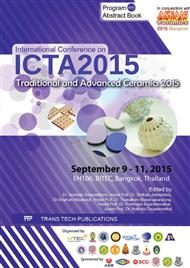p.230
p.236
p.240
p.246
p.252
p.259
p.264
p.268
p.272
Mechanical Behavior of Fired-Clay Bricks from Stream Sediments under Uniaxial Compressive Loading
Abstract:
In the northeast of Thailand, raw material for fired-clay brick is obtained from fine stream sediments in the lower Nam Phong and upper Chi River sub-watersheds. Hundreds of brickyards exist along the waterway producing rice husk ash (RHA) bricks for construction. Technical study on the production of these bricks is limited, therefore, detailed studies on mechanical and chemical properties will enhance the understanding of the production process in order for further improvement. In this study, a preliminary investigation of the brickyards and production process was conducted. Brick samples as well as raw sediment materials were collected from 6 randomly selected locations for laboratory testing on physical, chemical, and mechanical properties. A total of 300 brick specimens were collected being 50 specimens from each location. The brick dimensions are roughly 5×5×15 cm with an average weight of about 680 g. X-Ray Diffractometry show that the fired brick composition is approximately 90-98% quartz, 5-7% clay minerals, and less than 1% minor minerals. Mechanical behavior of the fired-clay bricks was evaluated by compressive loading of single brick units conducted under dry and submerged (with reverse osmosis water) conditions. The compressive strength of the brick unit is found to be proportional to its density with values in the range of about 0.4-1.2 MPa. Bricks with RHA to sediment ratio of 1:3 exhibit a higher average strength that that of other ratios.
Info:
Periodical:
Pages:
252-258
Citation:
Online since:
May 2016
Authors:
Price:
Сopyright:
© 2016 Trans Tech Publications Ltd. All Rights Reserved
Share:
Citation:


